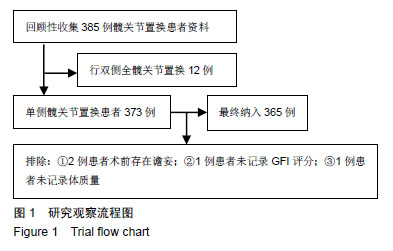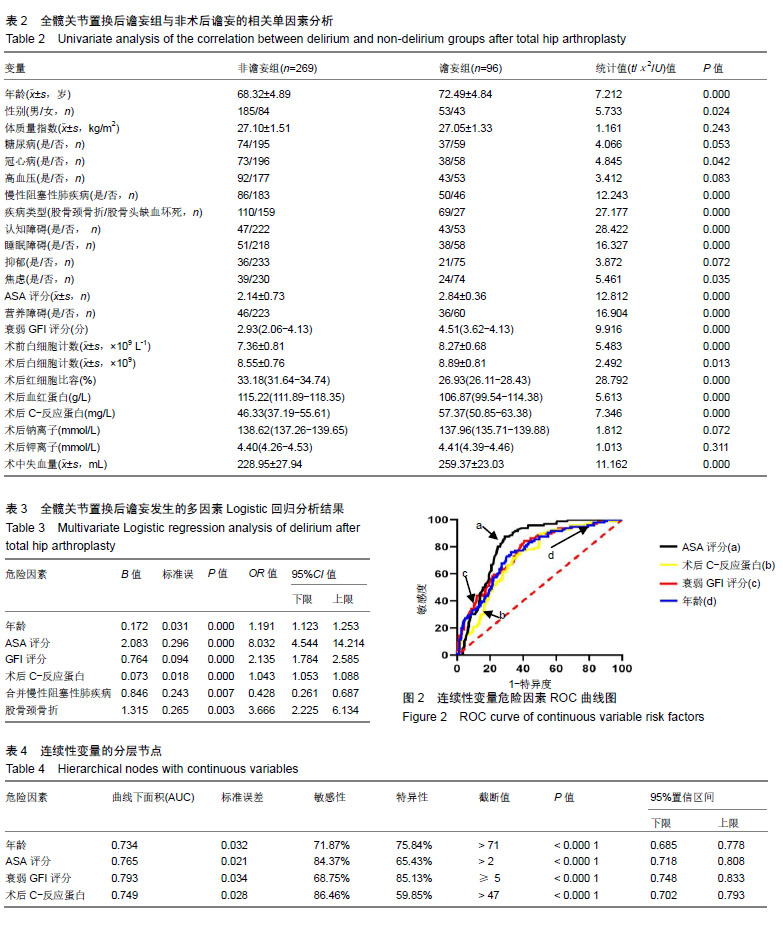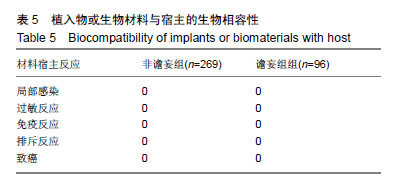| [1]Simon ST, Gomes B, Koeskeroglu P, et al. Population, mortality and place of death in Germany (1950-2050)-implications for end-of-life care in the future. Public Health. 2012;126(11):937-946. [2]Hoorntje A, Janssen KY, Sbt B, et al. The effect of total hip arthroplasty on sports and work participation: a systematic review and meta-analysis. Sports Med. 2018;48(6):1-32. [3]Capone A, Bienati F, Torchia S, et al. Short stem total hip arthroplasty for osteonecrosis of the femoral head in patients 60 years or younger: a 3- to 10-year follow-up study. BMC Musculoskelet Disord. 2017;18(1):301. [4]Barbosa FT, Da CR, Pinto AL. Postoperative delirium in the elderly. Rev Bras Anestesiol. 2008;58(58):665-670. [5]Saczynski JS, Marcantonio ER, Quach L, et al. Cognitive Trajectories after Postoperative Delirium. New Engl J Med. 2012,367(1):30-39.[6]Jones CA, Jhangri GS, Feeny DH, et al. Cognitive status at hospital admission: postoperative trajectory of functional recovery for hip fracture. J Gerontol A Biol Sci Med Sci. 2017;72(1):61-67. [7]Watt J, Tricco AC, Talbot-Hamon C, et al. Identifying older adults at risk of delirium following elective surgery: a systematic review and meta-analysis. J Gen Intern Med. 2018;16(1):1-10. [8]Gleason LJ, Schmitt EM, Kosar CM, et al. Effect of delirium and other major complications on outcomes after elective surgery in older adults. JAMA Surg. 2015;150(12):1134-1140. [9]Hamilton GM, Wheeler K, Michele JD, et al. A systematic review and meta-analysis examining the impact of incident postoperative delirium on mortality. Anesthesiology. 2017;127(1):78-88.[10]Schenning KJ, Deiner SG. Postoperative delirium in the geriatric patient. Anesthesiol Clin. 2015;33(3):505-516. [11]Organization WH. World Health Organization launches new initiative to address health needs of a rapidly ageing population. Cent Eur J Public Health. 2004;12(4):210-216.[12]Hooijer C, Dinkgreve M, Jonker C, et al. Short screening tests for dementia in the elderly population. I. A comparison between AMTS, MMSE, MSQ and SPMSQ. Int J Geriatr Psychiatry. 1992;7(8): 559-571. [13]李建明.睡眠状况自评量表(SRSS)简介[J].中国健康心理学杂志,2012, 20(12):1851-1851.[14]Zung WW. Factors influencing the self-rating depression scale. Arch Gen Psychiatry. 1967;16(5):543.[15]Jegede RO. Psychometric attributes of the Self-Rating Anxiety Scale. Psychol Rep. 1977;40(1):303-306. [16]Rubenstein LZ, Harker JO, Salvà A, et al. Screening for undernutrition in geriatric practice: developing the short-form mini-nutritional assessment (MNA-SF). J Gerontol. 2001;56(6): M366-M372. [17]Steverink N, Slaets JPJ, Schuurmans H, et al. Measuring frailty: developing and testing the gfi (groningen frailty indicator). Gerontologist. 2001;41(Special Issue 1):236-237. [18]Wei LA, Fearing MA, Sternberg EJ, et al. The Confusion Assessment Method: a systematic review of current usage. J Am Geriatr Soc. 2010;56(5):823-830. [19]Pollard C, Fitzgerald M, Ford K. Delirium: The lived experience of older people who are delirious post-orthopaedic surgery. Int J Ment Health Nurs. 2015;24(3):213-221. [20]Wang LH, Xu DJ, Wei XJ, et al. Electrolyte disorders and aging: risk factors for delirium in patients undergoing orthopedic surgeries. BMC Psychiatry. 2016;16(1):418. [21]Raats JW, Eijsden WAV, Crolla RMPH, et al. Risk factors and outcomes for postoperative delirium after major surgery in elderly patients. PLoS One. 2015;10(8):e0136071. [22]Brown CH 4th, Max L, LaFlam A, et al. The association between preoperative frailty and postoperative delirium after cardiac surgery. Anesth Analg. 2016;123(2):430-435. [23]Jung P, Pereira MA, Hiebert B, et al. The impact of frailty on postoperative delirium in cardiac surgery patients. J Thorac Cardiovasc Surg. 2015;149(3):869-875. [24]Soysal P, Stubbs B, Lucato P, et al. Inflammation and frailty in the elderly: a systematic review and meta-analysis. Ageing Res Rev. 2016;31:1-8.[25]Alsop DC, Fearing MA, Johnson K, et al. The role of neuroimaging in elucidating delirium pathophysiology. J Gerontol. 2006;61(12): 1287-1293. [26]Alsop DC, Fearing MA, Johnson K, et al. Review article the role of neuroimaging in elucidating delirium pathophysiology. J Gerontol. 2006;61(12):1287-1293. [27]Vcon Gool WA, van de Beek D, Eikelenboom P. Systemic infection and delirium: when cytokines and acetylcholine collide. Lancet. 2010;375(9716):773-775. [28]Lakstygal A, Kolesnikova T, Khatsko S, et al. DARK classics in chemical neuroscience: atropine, scopolamine and other anticholinergic deliriant hallucinogens. ACS Chem Neurosci, 2018. DOI: 10.1021/acschemneuro.8b00615.[29]李呈凯,白树财,宋秀钢,等.老年髋部骨折患者术后谵妄相关危险因素的回顾性研究[J].中华骨科杂志,2018,38(4):250-256. [30]Brouquet A, Cudennec T, Benoist S, et al. Impaired mobility, ASA status and administration of tramadol are risk factors for postoperative delirium in patients aged 75 years or more after major abdominal surgery. Ann Surg. 2010;251(4):759-765. [31]Chen CC, Lin MT, Liang JT, et al. Pre-surgical geriatric syndromes, frailty, and risks for postoperative delirium in older patients undergoing gastrointestinal surgery: prevalence and red flags. J Gastrointest Surg. 2015;19(5):927-934. [32]Leung JM, Tsai TL, Sands LP. Preoperative frailty in older surgical patients is associated with early postoperative delirium. Anesth Analg. 2011;112(5):1199-1201. [33]Van-Munster B, Korevaar JC, Zwinderman AH, et al. Time-course of cytokines during delirium in elderly patients with hip fractures. J Am Geriatr Soc. 2010;56(9):1704-1709. [34]Dillon ST, Vasunilashorn SM, Ngo L, et al. Higher c-reactive protein levels predict postoperative delirium in older patients undergoing major elective surgery: a longitudinal nested case-control study. Biol Psychiatry. 2017;81(2):145-153.[35]Jakub K, Andrzej B, Joanna L, et al. Raised IL-2 and TNF-α concentrations are associated with postoperative delirium in patients undergoing coronary-artery bypass graft surgery. Int Psychogeriatr. 2014;26(5):845-855.[36]Pol RA, van Leeuwen BL, Izaks GJ, et al. C-reactive protein predicts postoperative delirium following vascular surgery. Ann Vasc Surg. 2014;28(8):1923-1930.[37]Björkelund KB, Hommel A, Thorngren KG, et al. Reducing delirium in elderly patients with hip fracture: a multi-factorial intervention study. Acta Anaesthesiol Scand. 2010;54(6):678-688. [38]Wei W, Hong-Liang L, Dong-Xin W, et al. Haloperidol prophylaxis decreases delirium incidence in elderly patients after noncardiac surgery: a randomized controlled trial. Crit Care Med. 2012;40(3): 731-739. |
.jpg)
.jpg)



.jpg)
.jpg)